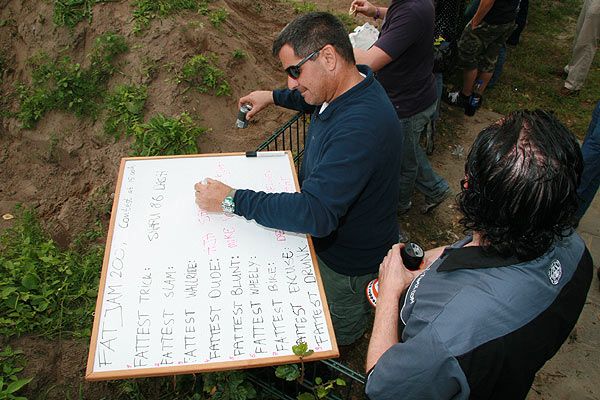 -June 1980: Hung up my BMX bike after my last NBL National after graduating from high school and entered Junior College. I kept in touch with my various sponsors and friends in the BMX scene at that time, but I didn't race again until cruisers came on the scene in 1981…
-June 1980: Hung up my BMX bike after my last NBL National after graduating from high school and entered Junior College. I kept in touch with my various sponsors and friends in the BMX scene at that time, but I didn't race again until cruisers came on the scene in 1981…
 -1982: Hooked up with my old friends Greg Esser, Greg Hill, Stu Thomsen and others on the NBL summer BMX tour. I raced a cruiser. I'd been touring the eastern USA racing nationals since 1978, but this was the best summer ever. My travels that year took me to California for the first time in my life, where I met with my old sponsor Torker. The family that owned Torker and Max offered me a job in October of this year. I was living with Greg Esser's family and working at the NBL at the time, so I quit my job as editor of the NBL newspaper and moved to California in December.
-1982: Hooked up with my old friends Greg Esser, Greg Hill, Stu Thomsen and others on the NBL summer BMX tour. I raced a cruiser. I'd been touring the eastern USA racing nationals since 1978, but this was the best summer ever. My travels that year took me to California for the first time in my life, where I met with my old sponsor Torker. The family that owned Torker and Max offered me a job in October of this year. I was living with Greg Esser's family and working at the NBL at the time, so I quit my job as editor of the NBL newspaper and moved to California in December.
 -1983-1984: Worked at Torker and Max as the team manager. Max was an apparel brand that sponsored various BMX teams and young freestyle riders in the sport's earliest days. One of those early freestyle pioneers was Bob Haro. Bob rode a Torker frame and wore Max racing pants. In November of 1982 Haro introduced his own line of racing pants at the ABA Grands. The people at Max weren't happy about that, and they asked me to let Bob know that we wouldn't be sending him his salary check for the month of December. My first official job at Max and Torker was to fire Bob Haro! I had only known Bob briefly for a year or so before that, and he was one of my heroes. Firing one of my heroes was something I would do more than once in my BMX career...
-1983-1984: Worked at Torker and Max as the team manager. Max was an apparel brand that sponsored various BMX teams and young freestyle riders in the sport's earliest days. One of those early freestyle pioneers was Bob Haro. Bob rode a Torker frame and wore Max racing pants. In November of 1982 Haro introduced his own line of racing pants at the ABA Grands. The people at Max weren't happy about that, and they asked me to let Bob know that we wouldn't be sending him his salary check for the month of December. My first official job at Max and Torker was to fire Bob Haro! I had only known Bob briefly for a year or so before that, and he was one of my heroes. Firing one of my heroes was something I would do more than once in my BMX career...
 -1984-1985: Torker went bankrupt and I became unemployed. My friend Dean Bradley had recently quit his job as editor at BMX Plus! magazine, so I interviewed to be his replacement. John Ker hired me on the spot. Things at BMX Plus! were really cool for six months, but I missed working in the bike business. An old workmate of mine at Torker called me and said CW needed a freestyle team manager. I took that job and hired Dizz Hicks and Ceppie Maes to tour with Mike Buff and me on the 1985 CW Freestyle Tour. After three months on the road with Dizz it was easy to see that Mike Buff's days were over. Mike Buff quit riding, Dizz Hicks became the star of our show and Ceppie Maes and I became roommates. I travelled around the USA three times in 15 months with the CW Trick Team. My contributions to the CW program caught the eye of the marketing direct at GT Bicycles.
-1984-1985: Torker went bankrupt and I became unemployed. My friend Dean Bradley had recently quit his job as editor at BMX Plus! magazine, so I interviewed to be his replacement. John Ker hired me on the spot. Things at BMX Plus! were really cool for six months, but I missed working in the bike business. An old workmate of mine at Torker called me and said CW needed a freestyle team manager. I took that job and hired Dizz Hicks and Ceppie Maes to tour with Mike Buff and me on the 1985 CW Freestyle Tour. After three months on the road with Dizz it was easy to see that Mike Buff's days were over. Mike Buff quit riding, Dizz Hicks became the star of our show and Ceppie Maes and I became roommates. I travelled around the USA three times in 15 months with the CW Trick Team. My contributions to the CW program caught the eye of the marketing direct at GT Bicycles.
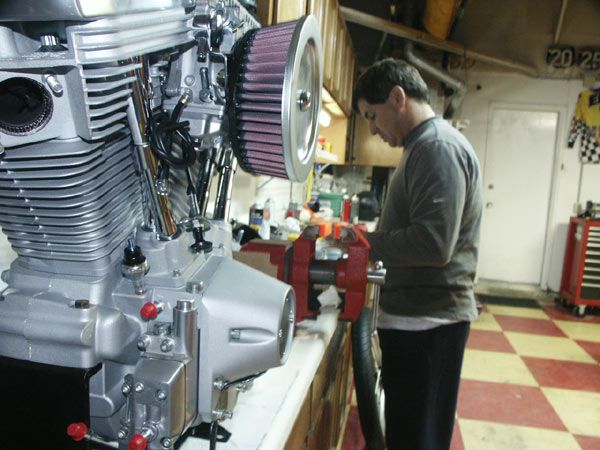 -1986-1988: GT offered me a job. I took it. My boss at GT was a jerk, but I used the opportunity to gain experience in other facets of the bike business. I became a product manager for the BMX side, I managed the freestyle and race team at GT for two years, and I wrote all the copy for GT, DYNO and GT MTB catalogs for three years. When it became obvious to me that I had hit the ceiling at GT, I handed Rich Long my resignation and moved to Mongoose.
-1986-1988: GT offered me a job. I took it. My boss at GT was a jerk, but I used the opportunity to gain experience in other facets of the bike business. I became a product manager for the BMX side, I managed the freestyle and race team at GT for two years, and I wrote all the copy for GT, DYNO and GT MTB catalogs for three years. When it became obvious to me that I had hit the ceiling at GT, I handed Rich Long my resignation and moved to Mongoose.
 -1988-1990: At Mongoose I met the man who would become my mentor in the bicycle business: Bob Margevicius. Bob was smart, hard working, super experienced and very generous and trusting. He gave me 100% authority to do anything I said was necessary to improve the Mongoose BMX brand, which was a distant #4 in BMX at that time (GT was #1, Haro was #2, Diamondback was #3). I immediately hired Dennis McCoy to help me design and promote a new line of freestyle bikes, and I hired Fuzzy Hall to improve Mongoose's image in dirt jumping.
-1988-1990: At Mongoose I met the man who would become my mentor in the bicycle business: Bob Margevicius. Bob was smart, hard working, super experienced and very generous and trusting. He gave me 100% authority to do anything I said was necessary to improve the Mongoose BMX brand, which was a distant #4 in BMX at that time (GT was #1, Haro was #2, Diamondback was #3). I immediately hired Dennis McCoy to help me design and promote a new line of freestyle bikes, and I hired Fuzzy Hall to improve Mongoose's image in dirt jumping.
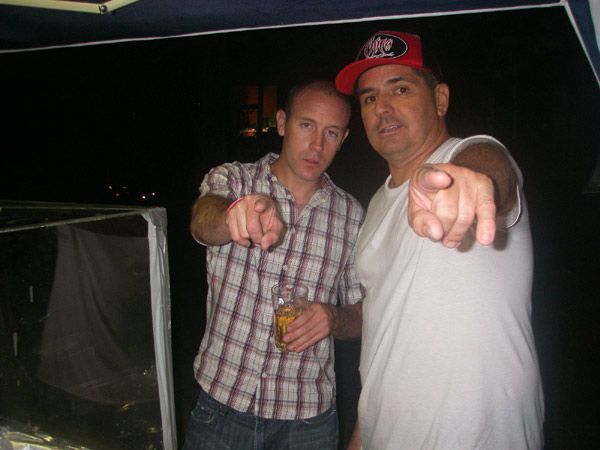 -1991: I thought it would be funny to put a photo of a black transvestite on the cover of the Mongoose BMX catalog. Bob's bosses thought otherwise. Bob was forced to fire me at Mongoose. After working for the #1 company in BMX and helping to reinvent Mongoose for the '90s, I decided to try other things. I started a small mail order company with no money called Mental Jimmy's. The idea behind MJ's was to sell kids what they needed for BMX, not what they wanted. It was an uphill battle, and not even my friend John Paul Rogers could help me win that fight. We killed Mental Jimmy's in 1994 and I focused 100% of my energy on my small advertising agency called Revolution.
-1991: I thought it would be funny to put a photo of a black transvestite on the cover of the Mongoose BMX catalog. Bob's bosses thought otherwise. Bob was forced to fire me at Mongoose. After working for the #1 company in BMX and helping to reinvent Mongoose for the '90s, I decided to try other things. I started a small mail order company with no money called Mental Jimmy's. The idea behind MJ's was to sell kids what they needed for BMX, not what they wanted. It was an uphill battle, and not even my friend John Paul Rogers could help me win that fight. We killed Mental Jimmy's in 1994 and I focused 100% of my energy on my small advertising agency called Revolution.
 -1995 to present: In 1995 an art director at another small specialty agency named Bill Bryant and I combined energies and clients to make Revolution a stronger presence in the bicycle business. In 1999 we used our connections and experience to start SNAFU BMX. We followed that start-up with another in 2002. That company is called Universal Motocross. In 2006 we hooked up with our friend Chris Collins to start a custom motorcycle parts and accessory company called Biltwell Inc. Managing Biltwell and SNAFU and providing creative services to several other companies in the bike business keeps us really busy, but we've never been happier. I travel around the world, I work with great people, and I spend every waking minute thinking about bikes, motorcycles and business. What could be better?
-1995 to present: In 1995 an art director at another small specialty agency named Bill Bryant and I combined energies and clients to make Revolution a stronger presence in the bicycle business. In 1999 we used our connections and experience to start SNAFU BMX. We followed that start-up with another in 2002. That company is called Universal Motocross. In 2006 we hooked up with our friend Chris Collins to start a custom motorcycle parts and accessory company called Biltwell Inc. Managing Biltwell and SNAFU and providing creative services to several other companies in the bike business keeps us really busy, but we've never been happier. I travel around the world, I work with great people, and I spend every waking minute thinking about bikes, motorcycles and business. What could be better?
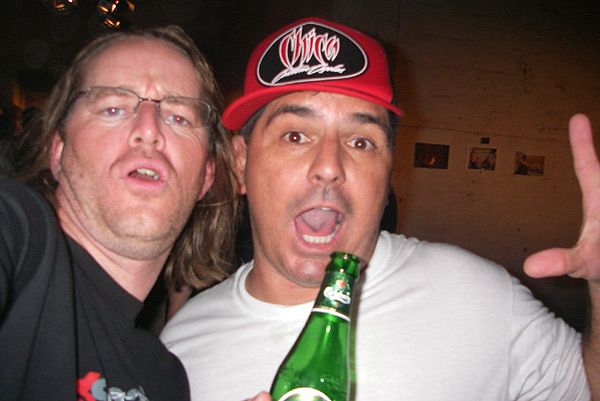 Could you (in short) give the differences between BMX in the seventies, the eighties, the nineties and the new millennium?
Could you (in short) give the differences between BMX in the seventies, the eighties, the nineties and the new millennium?
McGoo: In the 1970's EVERYONE was learning about BMX as we moved along: track operators, magazine publishers, bike factories, Taiwanese and Japanese parts makers, riders, EVERYONE. It was a great time to be involved with the sport, because we were building an industry as we moved along.
 The 1980's were very good for some early BMX pioneers, and very bad for some others. If you were open minded and forward thinking, there were many good opportunities. Two examples are Mountain Bikes and Freestyle. Bob Haro defined forward thinking in the 1980's by turning some of his attention away from his core business--BMX race accessories--to build an empire in the new sport of Freestyle. Many other BMX race brands followed Haro's lead in this direction, but only a few survived. I worked for two of those survivors (GT and Mongoose.) Unfortunately, many great race brands could not or would not keep pace with these leaders. As a result, we saw race brands like JMC, SE, CW, Patterson and dozens of others die a painful death in the 1980's.
The 1980's were very good for some early BMX pioneers, and very bad for some others. If you were open minded and forward thinking, there were many good opportunities. Two examples are Mountain Bikes and Freestyle. Bob Haro defined forward thinking in the 1980's by turning some of his attention away from his core business--BMX race accessories--to build an empire in the new sport of Freestyle. Many other BMX race brands followed Haro's lead in this direction, but only a few survived. I worked for two of those survivors (GT and Mongoose.) Unfortunately, many great race brands could not or would not keep pace with these leaders. As a result, we saw race brands like JMC, SE, CW, Patterson and dozens of others die a painful death in the 1980's.
 In the early 1990's, nearly every leading bike company in the world had switched its energy and resources to the growing Mountain Bike scene. BMX went underground in this era, and would not resurface as a powerful force on the youth market until ESPN fine-tuned the X Games in the late 1990's. This era saw rapid growth in the "rider owned" company scene. S&M exploded in this era, and dozens of small companies were started by part-time riders/businessmen at this time. My own business was able to flourish in this era because Bill and I applied underground marketing strategies to big brands. In the 1990's I think everyone learned the importance of moving rapidly and having a plan. Companies whose business plan didn't include being fast-moving and flexible saw hard times in the 1990's. I'm thinking of companies like GT, Schwinn and Mongoose. These companies saw their BMX fortunes dwindle in the 1990's because Haro, S&M and dozens of other smaller BMX companies could adapt more quickly to the market's rapidly shifting needs.
In the early 1990's, nearly every leading bike company in the world had switched its energy and resources to the growing Mountain Bike scene. BMX went underground in this era, and would not resurface as a powerful force on the youth market until ESPN fine-tuned the X Games in the late 1990's. This era saw rapid growth in the "rider owned" company scene. S&M exploded in this era, and dozens of small companies were started by part-time riders/businessmen at this time. My own business was able to flourish in this era because Bill and I applied underground marketing strategies to big brands. In the 1990's I think everyone learned the importance of moving rapidly and having a plan. Companies whose business plan didn't include being fast-moving and flexible saw hard times in the 1990's. I'm thinking of companies like GT, Schwinn and Mongoose. These companies saw their BMX fortunes dwindle in the 1990's because Haro, S&M and dozens of other smaller BMX companies could adapt more quickly to the market's rapidly shifting needs.
 BMX celebrated its 30th birthday in the early part of the 21st century. There are people younger than me in BMX whose 12-year-old sons are getting into the sport for the first time. Everything old is new again: drilled out rims were invented by Mongoose in 1982. Lightweight clamp-on stems have been a staple in MTB's for 17 years. Brian Foster has been doing the best tabletop 360's for nearly 20 years! The limits of what's possible on a BMX bike are being pushed like never before. I find the state of BMX in the 21st century especially interesting because the bikes that are being ridden today have more in common with my 1979 Schwinn Sting than they do with my 1999 S&M Holmes: 36-spoke alloy wheels, tapered rear stays, tapered fork legs, tubular chromoly three-piece cranks; one-piece machined alloy sprockets, plastic pedals! It is cliche to say it, but BMX is living proof that the more things change, the more they stay the same.
BMX celebrated its 30th birthday in the early part of the 21st century. There are people younger than me in BMX whose 12-year-old sons are getting into the sport for the first time. Everything old is new again: drilled out rims were invented by Mongoose in 1982. Lightweight clamp-on stems have been a staple in MTB's for 17 years. Brian Foster has been doing the best tabletop 360's for nearly 20 years! The limits of what's possible on a BMX bike are being pushed like never before. I find the state of BMX in the 21st century especially interesting because the bikes that are being ridden today have more in common with my 1979 Schwinn Sting than they do with my 1999 S&M Holmes: 36-spoke alloy wheels, tapered rear stays, tapered fork legs, tubular chromoly three-piece cranks; one-piece machined alloy sprockets, plastic pedals! It is cliche to say it, but BMX is living proof that the more things change, the more they stay the same.
 You have been going to Taiwan since you got your job at Mongoose almost 20 years ago. Do you know your way around over there?
You have been going to Taiwan since you got your job at Mongoose almost 20 years ago. Do you know your way around over there?
McGoo: I went to Taiwan for the first time in the summer of 1985, right after my first of three CW freestyle tours. On that trip I met my current friend and business partner Sherry Shu. Sherry is the person who helped me and Bill launch SNAFU BMX, and she is the person many rider-owned BMX companies rely on today to find factories in Taiwan. I love going to Taiwan, and the people I work with at some factories are the most talented and friendly people in the bike business. I love it in Taiwan.
There was a time when everything that came out of Taiwan was considered crap. What have they done (in Taiwan) to change that?
McGoo: In the 70's all the best bike parts came from Europe and all the cheap stuff came from Japan.
In the 80's all the best stuff came from Japan and all the cheap stuff came from Taiwan.
In the 90's the good stuff started coming from Taiwan and the cheap stuff shifted to China.
 Well established Taiwan factories were aware of this fact, and they did everything possible to stop the shift of production to cheaper labor markets. This included investing millions of dollars in US design facilities and warehouses, and even in entire US brands. As I mentioned earlier, SNAFU was started by a smart Taiwanese factory owner and trading agent. Primo, Specialized, Mosh, Giant... the list of top bike brands that are owned in whole or part by smart Taiwanese businessmen is very long. I think Taiwan will be the #1 source for the world's best BMX parts for many years to come. Hard-core rider owned companies seem to agree with this opinion, because all of them get the bulk of their products from the same Taiwanese sources (Cheng Shin, Duro or Kenda for tires, Velo for saddles, etc.)
Well established Taiwan factories were aware of this fact, and they did everything possible to stop the shift of production to cheaper labor markets. This included investing millions of dollars in US design facilities and warehouses, and even in entire US brands. As I mentioned earlier, SNAFU was started by a smart Taiwanese factory owner and trading agent. Primo, Specialized, Mosh, Giant... the list of top bike brands that are owned in whole or part by smart Taiwanese businessmen is very long. I think Taiwan will be the #1 source for the world's best BMX parts for many years to come. Hard-core rider owned companies seem to agree with this opinion, because all of them get the bulk of their products from the same Taiwanese sources (Cheng Shin, Duro or Kenda for tires, Velo for saddles, etc.)
 Do you believe it's okay to shift bike production to China, Vietnam and other lower paid countries?
Do you believe it's okay to shift bike production to China, Vietnam and other lower paid countries?
McGoo: In 1984 I bought a Honda Civic for $8,600. Torker entry-level BMX bikes in 1984 were $280. The Torker BMX bike had one-piece cranks, single-wall alloy rims and a mild steel frame. In 2004 a Honda Civic cost $16,000 and a BMX bike with a mild steel frame and one-piece cranks cost $149. Why did the price of the car double in 20 years, but the cost of the bike went in half? Labor.
 The 1984 Torker had a parts kit from Japan and a frame that was welded in Southern California. The 2004 BMX bike was made in China. Bike companies don't just compete with each other; they compete for expendable income with everything in the world: $79 iPods, $99 cell phones, $289 video games and $599 laptop computers.
The 1984 Torker had a parts kit from Japan and a frame that was welded in Southern California. The 2004 BMX bike was made in China. Bike companies don't just compete with each other; they compete for expendable income with everything in the world: $79 iPods, $99 cell phones, $289 video games and $599 laptop computers.
Chris Moeller once told me if he could build a great BMX frames out of pineapple skins, he'd move to Hawaii. Cory Muth at Verde is moving to Taiwan soon because that's where good BMX bikes are being built today. If Viet Nam, China or India get their shit together, I bet my last dollar smart BMX product managers will go there.
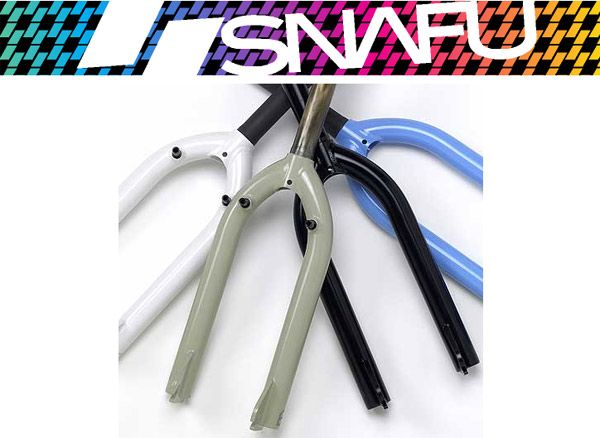 When did SNAFU start?
When did SNAFU start?
McGoo: 1999.
In what way have you been able to use your connections and experience to SNAFU's benefit?
McGoo: Sometimes my connections and experience have done SNAFU more harm than good. One example: When BMX sales were going into the toilet in 2002, I told our customers we wouldn't design any new products until their inventory levels on older stuff were depleted. In a single year after I made that announcement to our business partners, Odyssey and Fly came out with a ton of new shit. SNAFU appeared to be off the back in terms of product development, and Mike Collins and I have been digging ourselves out of that hole ever since.
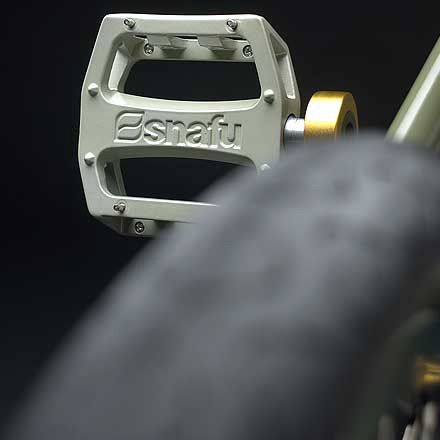 Today I leave the business of building the SNAFU brand 100% in the hands of Mike Collins and Bill Bryant. They have their collective eye on the market, and they stay ahead of modern BMX marketing much better than I can. Mike personally hand-picked everyone on the 2008 SNAFU Team. My efforts at SNAFU are confined to customer relations (many of SNAFU's global distributors have been my personal friends for over 20 years), and product development. Mike gets product ideas from the team riders and it's my job to make those products a reality. I like going to Taiwan and meeting with the engineers at all the factories, so this division of labor works perfectly.
Today I leave the business of building the SNAFU brand 100% in the hands of Mike Collins and Bill Bryant. They have their collective eye on the market, and they stay ahead of modern BMX marketing much better than I can. Mike personally hand-picked everyone on the 2008 SNAFU Team. My efforts at SNAFU are confined to customer relations (many of SNAFU's global distributors have been my personal friends for over 20 years), and product development. Mike gets product ideas from the team riders and it's my job to make those products a reality. I like going to Taiwan and meeting with the engineers at all the factories, so this division of labor works perfectly.
 What parts does SNAFU make?
What parts does SNAFU make?
McGoo: Everything but frames, headsets, freecoasters and sissy bars...
How many people are involved with the brand?
McGoo:
-Mike Collins: TM, global customer service, viral marketing, media and customer communications
-Bill Bryant: graphic design for products and packaging
-Sherry Shu; Taiwan liaison for all factories; freight consolidation and sourcing
 Has Snafu ever made a catalog?
Has Snafu ever made a catalog?
McGoo: We've never printed a catalog. In the age of the internet, what's the point? When we have a new product, Mike can tell all 3,000 of our Myspace and Vital BMX friends about it in a global bulletin in a matter of seconds for FREE. Our single greatest marketing overhead expense is rider salaries. It's nearly 30$ of every dime we spend marketing the brand. The BMX magazines created this monster when they stopped covering new products in their magazines. I'm glad Fat BMX and web sites like it show products to kids. If you can't do a 20-foot wall ride in Barcelona, products ARE a part of the BMX lifestyle. A kid can't ride every day, but he CAN dream about new parts for his bike.
 Special plans for 2008 with the brand?
Special plans for 2008 with the brand?
McGoo: We will begin rolling out the new SNAFU brand ID this winter and spring for Summer delivery. The new SNAFU lightning bolt logo is already showing up on Vital BMX, and we'll be sending new banner ads for FatBMX in a few days. New products that will debut in March include the following:
-Love seat (super lightweight standard rail saddle with crazy new covers  -Sterly, Malcolm, Sanford and Dirt Box tires with lightweight flex Kevlar beads
-Sterly, Malcolm, Sanford and Dirt Box tires with lightweight flex Kevlar beads
-Uni Seat (super lightweight padded plastic seat with integrated alloy seatpost)
-Mayweather cranks (lightest standard 3-pc chromoly crank in the market -Dave Mirra and Morgan Wade earn a living on this crank)
www.snafubmx.com
(Re-Up 1-3-2008) Interview with BMX guru Harold McGruther
 Name: Harold "McGoo" McGruther
Name: Harold "McGoo" McGruther
D.O.B.: 01/21/62
Hometown: Lake Elsinore, CA
You have been involved in BMX since the mid seventies, can you give us a little rundown how it all started and where you've been?
McGoo: That story could fill a book. Let me give you the short summary of the last 34 years so I don't bore any modern FatBMX readers:
-1974: helped build a BMX track in my home town of Bradenton, FL with neighborhood friends
-1974-1980: I brought up the back of the pack chasing points in expert-class BMX races from Homestead, FL, to upstate New York on the NBL War of The Stars National Series.
Related items
- Addressing the GT Bicycles Situation by Mossie Rides Bikes
- Tariffs, BMX Industry, & More With Chris Moeller - MooreBMX 060
- Vacancy: Shop assistant Soulcycle BMX Shop (Dutch Only)
- Inside a Multi Million Dollar Rider Owned BMX Bike Company [ CULT ] - Peep Game by Steve Croteau
- Get to Know Larry from Stacked BMX! by Cruising In the 808




 After doing a BMX 'zine for ten years (1987 - 1996) FATBMX made it on the internet. The year was 1998. Here to stay.
After doing a BMX 'zine for ten years (1987 - 1996) FATBMX made it on the internet. The year was 1998. Here to stay.